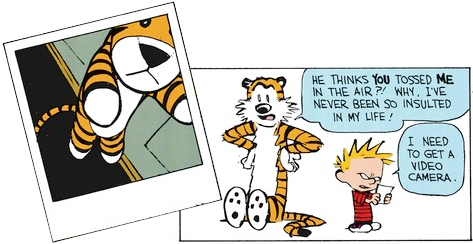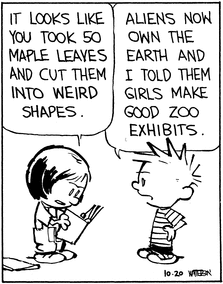Overview: What We're Investigating
I alluded to a discrepancy in the introduction, one that longtime Calvin & Hobbes fans will no doubt be familiar with. This discrepancy lies in how Hobbes is perceived. Calvin sees a living, breathing tiger pal, while everybody else sees a stuffed toy, incapable of autonomous action and lacking any sort of sentience. To hear the author tell it, this discrepancy does not, in fact, exist. In the 10th Anniversary Edition, Watterson writes:
The nature of Hobbes's reality doesn't interest me, and each story goes out of its way to avoid resolving the issue. [...] I show two versions of reality, and each makes complete sense to the participant who sees it. I think that's how life works. None of us sees the world in exactly the same way, and I just draw that literally in the strip.
Watterson frequently employs this juxtaposition to humorous effect, showing us the occasions where Calvin's reality clashes with that of the other people in his life. In one example, during a squirt gun fight with neighbor Susie, Calvin leaves Hobbes behind with a water balloon, expecting his teammate to go the opposite direction around the house to hit her from behind. Susie, coming across Hobbes and seeing that Calvin has trusted his stuffed tiger to safeguard the ammunition, takes the balloon and uses it against Calvin. After Calvin gets soaked, he considers Hobbes a traitor, a charge that Hobbes isn't quick to dispute.

Even when Calvin attempts to pin actions on Hobbes, his explanations are often met with skepticism. This is illustrated perfectly in a later strip, in which Calvin snaps a picture of an airborne Hobbes, thereby catching the tiger in the habitual act of pouncing on him as he returns home from school. However, in spite of this evidence, his dad remains unconvinced that Calvin is being savagely mauled by his "toy" every day.

But while these examples have fairly cut-and-dry explanations for why reality is being perceived in two ways, there are times when the direct influence that Hobbes has on the world can't be as easily dismissed by those who see him as a non-actor. As such, each entry in this project will examine one of these cases and determine just how much reality has to bend and warp to make things make sense. To put it another way: might we find evidence that proves Hobbes is truly alive beyond any shadow of doubt?
A word on Calvin's imagination
As I mentioned a few times already, Calvin's imagination is incredibly vivid, to the point where his version of events can differ wildly from what others would perceive reality to be. Take the weeks-long arc where—looking to easily complete his collection for a school assignment—Calvin trades away the Earth to extraterrestrials in exchange for leaves from 50 alien trees. This culminates in this remark from Susie at school the following day:

We are constantly being shown that Calvin is an unreliable narrator, which leaves us dependent upon an additional character—Mom, Dad, Susie, whoever—to help identify where the truths in Calvin's stories lie. Unfortunately, Calvin tends to spend a lot of his time with Hobbes engaged in activities completely free from outside observance. In these cases, we cannot take what the comic shows us at face value. It's for this reason that I'm going to be skipping over a lot of strips where we see Hobbes interacting with the world but which lack any sort of alternate perspective, simply because I don't think it's worth evaluating cases in which Calvin is the only witness. I would suggest that, in order to qualify for examination, a strip should satisfy the following conditions:
- Hobbes's actions must influence the world in a tangible way.
- Such influence has some likelihood of being noticed by another character.
This won't be a hard-and-fast rule, but should help provide a frame of reference for why I'm picking the strips that I'm picking. Now, enough preamble, let's get on with it.